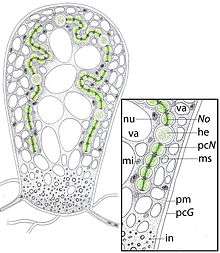Geosiphon
Geosiphon is a genus of fungus in the family Geosiphonaceae. The genus is monotypic, containing the single species Geosiphon pyriformis, first described by Kützing in 1849 as Botrydium pyriforme.[1] In 1915, Von Wettstein characterized Geosiphon pyriforme as a multinucleate alga containing endosymbiotic cyanobacteria, although he also noted the presence of chitin, a component of fungal cell walls.[2] In 1933, Knapp was the first to suggest the fungal origin of the species and described it as a lichen with endosymbiotic cyanobacteria.[3] It is the only member of the Glomeromycota known to not form a symbiosis with terrestrial plants in the form of arbuscular mycorrhiza.
| Geosiphon | |
|---|---|
 | |
| Scientific classification | |
| Kingdom: | Fungi |
| Division: | Glomeromycota |
| Class: | Glomeromycetes |
| Order: | Archaeosporales |
| Family: | Geosiphonaceae |
| Genus: | Geosiphon F.Wettst. (1915) |
| Type species | |
| Geosiphon pyriformis (Kütz.) F.Wettst. (1915) | |
Life cycle
Geosiphon pyriformis is known for being the symbiont of Nostoc. The Geosiphon-Nostoc symbiosis, as by modern definitions, is not a lichen, since it is an intracellular association. Also, by functional and evolutionary implications it is more comparable to the arbuscular mycorrhiza symbioses than to lichens.
The Geosiphon-Nostoc symbiosis is the only known fungal endosymbiosis with cyanobacteria and is characterised by a "siphonal bladder" that is made of a swollen fungal hypha, 0.5–2 mm in size and growing on the soil surface. The upper 2/3 of the "bladder" contains the Nostoc filaments and Nostoc heterocysts, the lower 1/3 is filled with lipid droplets.[4]
Reproduction
The fungal spores are 250 micrometres in diameter, formed at the end of one hypha, or intercalarly (within a hyphae) and resemble those of other members of the Glomeromycota, with a particular resemblance to spores of others in the polyphyletic genus Glomus. [5]
Somatic structure

Geosiphon has a specialised bladder used to harbour cyanobacteria, usually Nostoc punctiforme, although other Nostoc species are known to be incorporated by the fungus.[6] Geosiphon bladders are photosynthetically active,[7] and are also capable of fixing nitrogen from the atmosphere.[8] The walls of the bladder have a small pore radius (approximately 0.5 nm), which make it act as an osmotic barrier. This limits the free exchange of nutrients (like sugars) with the environment and increases the need to derive these carbon sources from internal sources.[9] It has been suggested that the organization of the symbiotic interface between the fungus and Nostoc in G. pyriforme is homologous to the symbiotic interface between plant and fungus in arbuscular mycorrhiza in terms of thickness, chitin content, and ultrastructure of layers.[10] G. pyriformis however, is not known to form arbuscular mycorrhiza.
The bladder structure may be considered to be equivalent to a symbiosome, a specialized membraned structure in some plants and animals that forms a structural and functional interface between the host and its symbiont counterpart.[11] The symbiosome may be divided into three functional areas:[10]
- the symbiosome membrane forms the border of the symbiosome. It is thought to be formed from the plasma membrane of the fungus by invagination during the uptake of the symbiont.[12]
- the symbiosome space, located between the symbiosome membrane and the endosymbiotic Nostoc cyanobacteria.
- the area containing the cyanobacteria.
The space between the symbiosome membrane and the Nostoc cell wall contains a 30–40 nm thick layer of carbohydrate material such as mannose, fucose, GalNAc, sialic acid, and galactose.[10]
References
- Kützing FT. (1848). Species algarum. Lipsiae (FA Brockhaus): Leipzig.
- Wettstein F von. (1915). Geosiphon Fr Wettst, eine neue, interessante Siphonee. Österr Bot Z 65: 145–56.
- Knapp E. (1933). Über Geosiphon pyriforme Fr. Wettst., eine intrazelluläre Pilz-Algen-Symbiose. Ber Dtsch Bot Ges 51: 210–17.
- Alexopolous CJ, Mims CW, Blackwell M. Introductory Mycology, 4thed. (John Wiley and Sons, Hoboken NJ, 2004) ISBN 0-471-52229-5
- Gehrig, H.; Kluge, M. (1996). "Geosiphon pyriforme, a Fungus Forming Endocyrobiosis with Nostoc (Cyanobacteria) Is an Ancestral Member of the Glomales: Evidence by SSU rRNA Analysis". Journal of Molecular Evolution.
- Kluge M. (1994) Geosiphon pyriforme (Kützing) von Wettstein, a promising system for studying endocyanoses. Prog Bot 55: 130–41.
- Kluge M, Mollenhauer D, Mollenhauer R. (1991) Photosynthetic carbon assimilation in Geosiphon pyriforme (Kfitzing) Fv Wettstein, an endosymbiotic association of fungus and cyanobacterium. Planta 185: 311–15.
- Kluge M, Kape R. (1992). Geosiphon pyriforme, an endosymbiotic consortium of a fungus and a cyanobacterium (Nostoc), fixes nitrogen. Bot Acta 105: 343–44.
- Schuessler A, Schnepf E, Mollenhauer D, Kluge M. (1995). The fungal bladders of the endocyanosis Geosiphon pyriforme, a Glomus-related fungus: Cell wall permeability indicates a limiting pore radius of only 0.5 nm. Protoplasma 185(3–4): 131–39.
- Schuessler A, Bonfante P, Schnepf E, Mollenhauer D, Kluge, M. (1996). Characterization of the Geosiphon pyriforme symbiosome by affinity techniques: Confocal laser scanning microscopy (CLSM) and electron microscopy. Protoplasma 190(1–2): 53–67.
- Catalano CM, Lane WS, Sherrier DJ (February 2004). "Biochemical characterization of symbiosome membrane proteins from Medicago truncatula root nodules". Electrophoresis. 25 (3): 519–31. doi:10.1002/elps.200305711. PMID 14760646.
- Schnepf E. (1964). Zur Feinstruktur von Geosiphon pyriforme. Arch Micobiol. 49: 112–31.